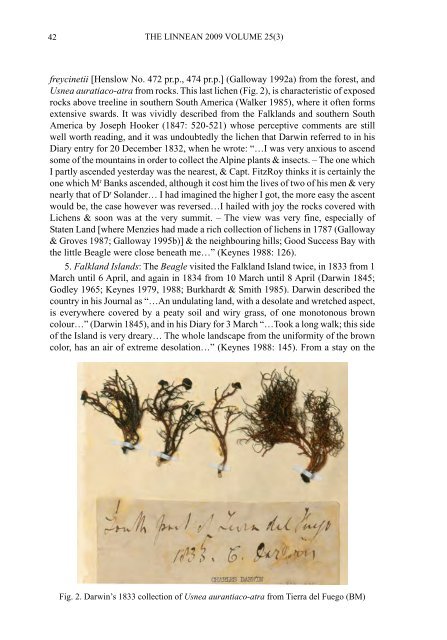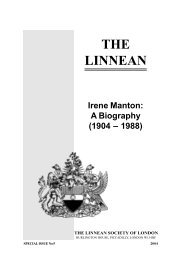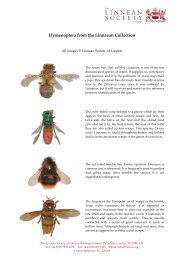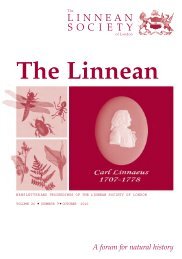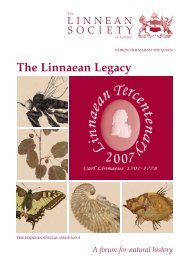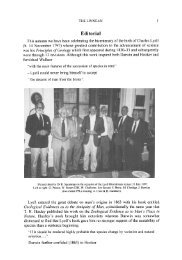Vol 25, no 3, October - The Linnean Society of London
Vol 25, no 3, October - The Linnean Society of London
Vol 25, no 3, October - The Linnean Society of London
You also want an ePaper? Increase the reach of your titles
YUMPU automatically turns print PDFs into web optimized ePapers that Google loves.
42<br />
THE LINNEAN 2009 VOLUME <strong>25</strong>(3)<br />
freycinetii [Henslow No. 472 pr.p., 474 pr.p.] (Galloway 1992a) from the forest, and<br />
Usnea auratiaco-atra from rocks. This last lichen (Fig. 2), is characteristic <strong>of</strong> exposed<br />
rocks above treeline in southern South America (Walker 1985), where it <strong>of</strong>ten forms<br />
extensive swards. It was vividly described from the Falklands and southern South<br />
America by Joseph Hooker (1847: 520-521) whose perceptive comments are still<br />
well worth reading, and it was undoubtedly the lichen that Darwin referred to in his<br />
Diary entry for 20 December 1832, when he wrote: “…I was very anxious to ascend<br />
some <strong>of</strong> the mountains in order to collect the Alpine plants & insects. – <strong>The</strong> one which<br />
I partly ascended yesterday was the nearest, & Capt. FitzRoy thinks it is certainly the<br />
one which M r Banks ascended, although it cost him the lives <strong>of</strong> two <strong>of</strong> his men & very<br />
nearly that <strong>of</strong> D r Solander… I had imagined the higher I got, the more easy the ascent<br />
would be, the case however was reversed…I hailed with joy the rocks covered with<br />
Lichens & soon was at the very summit. – <strong>The</strong> view was very fine, especially <strong>of</strong><br />
Staten Land [where Menzies had made a rich collection <strong>of</strong> lichens in 1787 (Galloway<br />
& Groves 1987; Galloway 1995b)] & the neighbouring hills; Good Success Bay with<br />
the little Beagle were close beneath me…” (Keynes 1988: 126).<br />
5. Falkland Islands: <strong>The</strong> Beagle visited the Falkland Island twice, in 1833 from 1<br />
March until 6 April, and again in 1834 from 10 March until 8 April (Darwin 1845;<br />
Godley 1965; Keynes 1979, 1988; Burkhardt & Smith 1985). Darwin described the<br />
country in his Journal as “…An undulating land, with a desolate and wretched aspect,<br />
is everywhere covered by a peaty soil and wiry grass, <strong>of</strong> one mo<strong>no</strong>to<strong>no</strong>us brown<br />
colour…” (Darwin 1845), and in his Diary for 3 March “…Took a long walk; this side<br />
<strong>of</strong> the Island is very dreary… <strong>The</strong> whole landscape from the uniformity <strong>of</strong> the brown<br />
color, has an air <strong>of</strong> extreme desolation…” (Keynes 1988: 145). From a stay on the<br />
Fig. 2. Darwin’s 1833 collection <strong>of</strong> Usnea aurantiaco-atra from Tierra del Fuego (BM)


